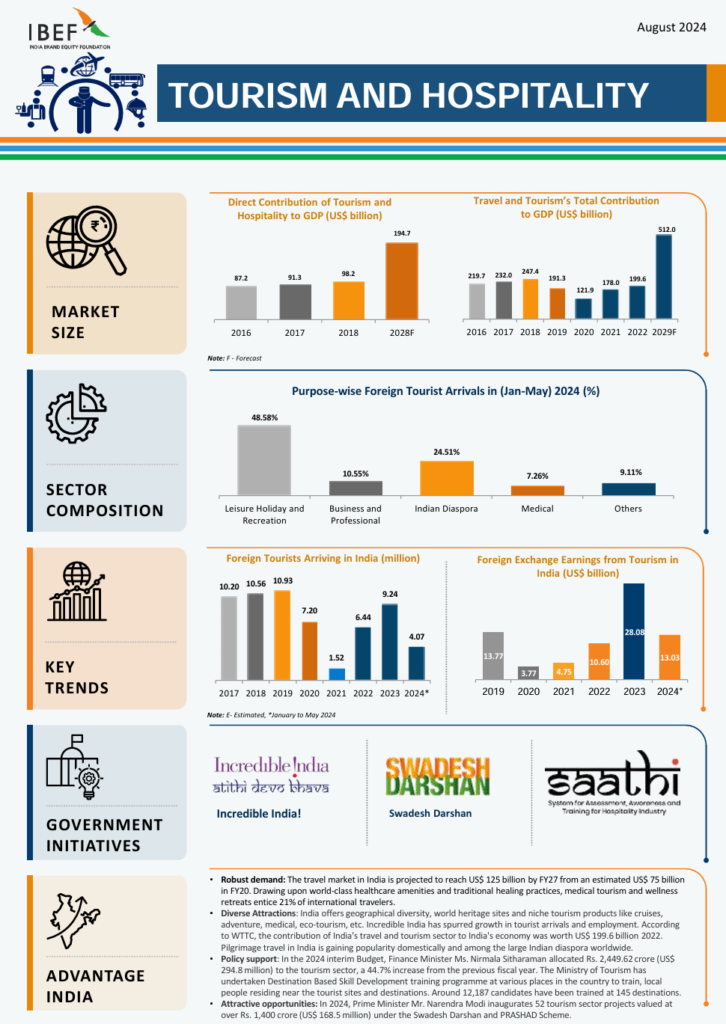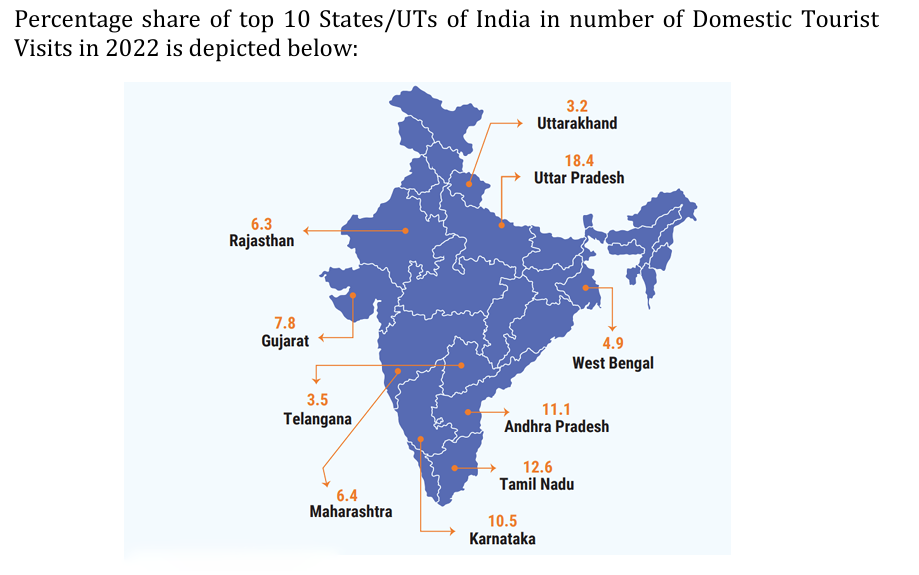World Tourism Day 2024

Introduction
On September 27, 2024, the Ministry of Tourism observed World Tourism Day under the theme “Tourism and Peace,” emphasizing how travel fosters understanding and connections between people from different cultural backgrounds.
What is the History of World Tourism Day?
- The United Nations World Tourism Organization (UNWTO) established World Tourism Day in 1980 to increase public awareness of the significance of tourism on a social, cultural, and economic level.
- On this day in 1975, the UNWTO’s laws were adopted, thus establishing the organization five years later.
- UNWTO supports the tourist industry in promoting knowledge and policy globally and promotes tourism as a driver of economic growth, inclusive development, and environmental sustainability.
- The UNWTO comprises more than 500 Affiliate Members, 6 Associate Members, 2 Observers, and 160 Member States, including India.
- Their main Headquartered is in Madrid, Spain.
What is the Annual Themes of World Tourism Day 2024?
- World Tourism Day is commemorated annually, with a subject and host nation chosen to showcase tourism’s many roles in various parts of the globe.
- Georgia will be honored to host this significant occasion in 2024. One especially motivating subject for World Tourism Day 2024 is “Tourism and Peace.”
- The day highlights how tourism can help achieve the UN’s Sustainable Development Goals (SDGs), especially in sustainable resource management and ending poverty. It also emphasizes how crucial ecotourism is to achieving SDG 13’s focus on reducing global warming.
What Role Does Tourism Play in Promoting Peace?
- Cultural Exchange: Through discourse and shared experiences, tourism reduces prejudice and fosters understanding and tolerance among other cultures.
- Economic Empowerment: As a primary engine of economic growth, tourism generates jobs and boosts local economies, which can reduce poverty and inequality, which can be the main causes of conflict. Tourism accounts for 10% of the global Gross Domestic Product (GDP), 7% of global exports, and one in every ten jobs globally.
- Sustainability: Conscientious tourism methods preserve the environment and cultural legacy, promoting communal harmony and mitigating conflicts associated with resources.
- Good Governance: Governments are encouraged to uphold stability and create regulations that advance harmony and efficiency while the tourist industry is booming.
- Gender Equality: The tourist sector involves local communities and gives women more power. The Indian Ministry of Tourism’s Tribal Home Stays program, part of the Swadesh Darshan initiative, attempts to give the tribal population an alternate source of income while also using the tourism potential of tribal regions.
- Pandemic Recovery: As seen in places like Rwanda, tourism helps to restore economies and foster reconciliation in post-conflict regions. After growing by 11% in 2021, Rwanda’s GDP increased by 8.4% in the first three quarters of 2022. The services sector, in particular the resurgence of tourism, was the driving force behind this increase, bringing employment indicators back to levels seen in early 2020, before the Covid-19 outbreak.
What is the Future of the Travel and Tourism Sector in India?
- Global Ranking: According to the World Economic Forum’s Travel and Tourism Development Index 2024, India is ranked 39th. Outstanding natural, cultural, and non-leisure resources—resources used for business, education, and other purposes outside leisure travel—are the main factors for its outstanding success.
- Economic Contribution
- The World Travel & Tourism Council (WTTC) estimates that in 2022, the travel and tourism industry in India will have contributed USD 199.6 billion to the country’s GDP.
- Between April 2000 and March 2024, the hotel and tourist sectors received a total of USD 17.2 billion in foreign direct investment (FDI). This represents 2.54% of the total foreign direct investment received in all industries.
- Domestic tourist visits (DTV) increased to 250 crore in 2023, almost twice as high as they were in 2014 (128 crore).
- Government Initiatives
- National Tourism Policy, 2022
- Dekho Apna Desh Initiative
- Swadesh Darshan Scheme
- Ek Bharat Shreshtha Bharat
- e-Visa Facility
- Cruise Tourism
- Growth Projections
- Annual Growth Rate: It is anticipated that the travel and tourism sector in India will expand at a 7.1% yearly pace.
- Job Creation: By 2030, the Indian government hopes to create 140 million jobs in the tourism industry through inclusive growth, with a special emphasis on cruise, eco, and adventure travel. This is a USD 56 billion currency ambition.
- Visitor Spending Trends: In 2022, expenditure by domestic tourists climbed by 20.4%, while spending by foreign tourists increased by 81.9%.
- Foreign Tourist Arrivals (FTAs): FTAs increased significantly from 6.43 million in 2022 to 9.24 million in 2023.

What are the Challenges Related to the Tourism Sector in India?
- Safety and Security Issues: There have been documented cases of theft and violence, which has created a fearful environment, especially for female travelers. These security concerns have the potential to discourage travelers from going to particular locations, which might harm India’s reputation as a traveler-friendly nation.
- Inadequate Infrastructure: Many popular tourist locations, particularly those in isolated areas like the Northeast, lack necessary transportation infrastructure including dependable train, air, and road connections. This affects both local and international travel by limiting access to stunning but unknown locations.
- Unskilled Human Resources: There is a dearth of skilled labor in the tourist industry, particularly multilingual guides. The entire experience of foreign visitors may be hampered by this lack, which may also affect the quality of services.
- Unsustainable Tourism Practices: Unsustainable tourism practices cause habitat damage, soil erosion, and resource depletion, particularly in environmentally delicate regions like the Himalayas. Local ecosystems and populations are strained by excessive resource usage.
- Pollution and Climate Change: The Taj Mahal and other popular tourist destinations are impacted by pollution. Additional risks posed by climate change include natural disasters that affect tourism infrastructure and cultural preservation.
What are the Benefits of Tourism in India?
- Rich Cultural Heritage: India is a linguistic, religious, and cultural patchwork. The city of Jaipur is home to several UNESCO World Heritage monuments, including the Taj Mahal, Hampi, and its forts, which draw history and culture-loving tourists.
- Natural Beauty
- 70% of the Himalayas are in India; these mountains are the backdrop to many hiking and adventure sports activities.
- 7,000 miles of coastline—perfect for beach vacations and aquatic sports. There are chilly and hot deserts in India.
- Vast forest cover may contribute to an increase in ecotourism.
- India’s biodiversity includes national parks like Jim Corbett and Kaziranga, home to distinctive flora and animals.
- Adventure Tourism Potential: Offering an array of experiences such as hiking, river rafting, paragliding, and wildlife safaris, India is well-positioned to emerge as a top adventure tourism destination.
- Affordable Travel Options: India is affordable when compared to many Western nations, making it a desirable destination for a wide spectrum of travelers from different socioeconomic backgrounds.
- Warm Hospitality
- The Indian philosophy of “Atithi Devo Bhava” (Guest is God) guarantees hospitable encounters for guests.
- In general, locals are happy to assist visitors and share their rich cultural history with them, which improves their entire experience.
- Culinary Diversity: The nation’s several regions, each with its specialties of vegetarian and non-vegetarian cuisine, provide a wide range of gastronomic experiences. Foodies looking for real regional flavors are catered to by its well-liked street food choices.
- Growing Infrastructure
- Expanding Infrastructure: As part of programs like Bharatmala, India is developing its travel infrastructure by building new highways, railways, and airports.
- The goals of investments in hospitality and skill development initiatives are to raise the standard of service and handle the increasing number of guests.

Way Forward
- Enhance Connectivity: To increase access to far-off tourist locations, spend money on infrastructure development and transportation projects like the Vande Bharat trains.
- Tax Simplification: To save expenses for travelers and businesses, push for simplified tax reforms that include a reduction in the Goods and Services Tax (GST) rates.
- Prioritise Safety: To increase travelers’ trust in safety, establish a tourism police force and put strong security measures in place.
- Skill Development: To raise the standard of service and cultural awareness among the staff in the tourist industry, fund training programs.
- Leverage Digital Technology
- Improve current programs, like as the Digi Yatra app, and employ Bhashini to enable multilingual support so that every user has a smooth travel experience.
- Use social media and online travel resources as well to promote places and expedite the planning process.
- Embrace Staycation Trends: Well-known hotel companies like Oberoi and Marriott are embracing the staycation trend by providing opulent escapes and carefully crafted experiences that reduce stress. Hotels can boost occupancy rates and boost the local economy by encouraging staycations, which result in more money being spent on local services and activities.
- International Partnerships
- Investigate travel spheres with nations such as Russia to promote tourism while putting in place health and safety measures.
- Sister cities are a great way to strengthen these relationships since they promote reciprocal support for tourist projects, economic cooperation, and cultural exchange.
Conclusion
World Tourism Day 2024 celebrates the theme of “Tourism and Peace,” highlighting how travel fosters cultural understanding and economic growth globally. As nations like Georgia host this occasion, the day underscores tourism’s role in achieving sustainable development goals and promoting harmony. Despite challenges like safety concerns and infrastructure gaps, India’s rich cultural heritage and biodiversity promise a vibrant future with enhanced connectivity and sustainable practices.
Frequently Asked Questions(FAQs)
Why is the World Tourism Day celebrated?
To recognize the worldwide impact of tourism and to raise public awareness of its significance for social, cultural, and economic development, the UNWTO founded World Tourism Day in 1980.
What is Tourism Day in India?
seeing India’s off-the-beaten-path locations, other travelers visit the most well-known places on earth.
What is the slogan of World Tourism Day?
‘Tourism and Peace’ is this year’s World Tourism Day theme. The subject emphasizes how the travel and tourism industry promotes international harmony and aids in reconciliation.
Who is the father of World Tourism Day?
It was the late Nigerian native Ignatius Amaduwa Atigbi who first suggested September 27 as World Tourism Day each year. In 2009, he received acknowledgment for his contributions at last.
Sources:
- https://www.un.org/en/observances/tourism-day
- https://en.wikipedia.org/wiki/World_Tourism_Day
- https://indianexpress.com/article/when-is/world-tourism-day-2024-know-the-date-history-significance-and-theme-9476511/
- https://ladakh.gov.in/world-tourism-day-celebrated-with-heritage-walk-cleanliness-drive-and-peace-walk/
- https://learnenglishteens.britishcouncil.org/study-break/magazine-zone/world-tourism-day
- https://www.hindustantimes.com/lifestyle/travel/world-tourism-day-2024-date-history-theme-host-country-wishes-images-facebook-and-whatsapp-status-to-share-101727319357535.html
- https://timesofindia.indiatimes.com/travel/travel-news/all-about-world-tourism-day-history-origins-theme-and-host-country-of-2024/articleshow/113694993.cms
Leave a Reply